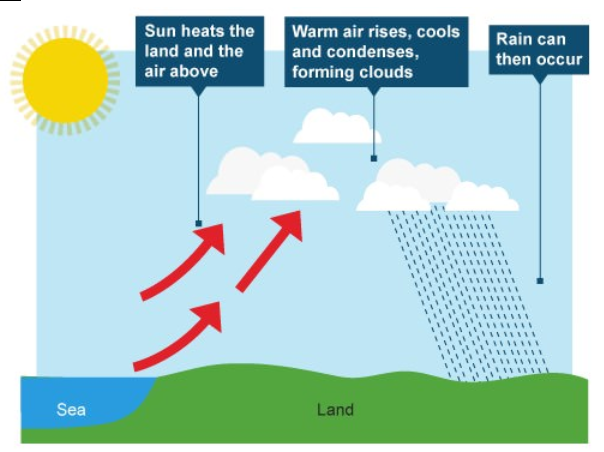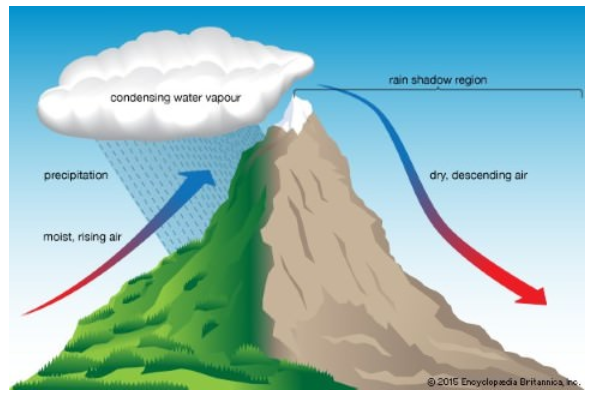Precipitation - Forms & Types
Precipitation encompasses any form of liquid or frozen water that forms in the atmosphere and eventually descends to the Earth's surface. Before precipitation occurs, water vapour or suspended water droplets accumulate in the Earth's atmosphere.
TYPES OF PRECIPITATION
Rainfall is commonly categorised into three primary types based on its origin: convectional, orographic (relief), and cyclonic (frontal).
CONVECTIONAL RAINFALL
- When air is heated, it becomes lighter and rises in convection currents.
- As it ascends, it expands, cools, and eventually condenses to form cumulus clouds.
- This process releases latent heat of condensation, further warming the air and compelling it to rise higher.
- Convectional precipitation tends to be intense but short-lived, localised, and is linked with minimal cloud cover.
- It primarily occurs during summer and is typical in regions like the equatorial doldrums within the Congo basin, the Amazon basin, and the islands of Southeast Asia.

OROGRAPHIC RAINFALL
- When a saturated air mass encounters a mountain, it's compelled to rise.
- As it ascends, the expanding air cools due to reduced pressure, leading to the condensation of moisture.
- This type of precipitation occurs when warm, humid air collides head-on with an orographic barrier, such as a mountain range.
- The upward movement of the moisture-laden air results in condensation and saturation, causing orographic precipitation along the windward slopes.
- Windward slopes receive more rainfall. After raining on the windward side, as these winds cross over to the other slope, they descend, their temperature rises, and their moisture-absorbing capability increases.
- Consequently, the leeward slopes remain dry and get less rainfall, creating a rain-shadow area.
- Arid and semi-arid regions, like the Patagonian desert in Argentina and the eastern slopes of the Western Ghats, are directly affected by the rain-shadow effect.
For instance, Mahabaleshwar in the Western Ghats receives over 600 cm of rainfall, whereas Pune, located in the rain-shadow area, gets only about 70 cm.
The wind descending on the leeward side is heated adiabatically and is known as Katabatic Wind.

FRONTAL RAINFALL
- When air masses with distinct temperatures collide, they create turbulent conditions.
- This collision at the front results in convection, leading to precipitation, a concept examined in the study of fronts.
- An illustration of this phenomenon is evident in northwest Europe, where the convergence of cold continental air with warm oceanic air generates heavy rainfall in neighbouring areas.

CYCLONIC RAINFALL
- Cyclonic rainfall is essentially convectional rainfall occurring on a larger scale.
- Precipitation within a tropical cyclone results from convection activity, while in a temperate cyclone, it's due to frontal activity.

FORMS OF PRECIPITATION
The different types of precipitation include:
Snow:
Ice water precipitation in the form of virga or flakes. Snow is commonly associated with high, thin, and fragile cirrus clouds and occurs when the air temperature is below freezing. Snowflakes can partially melt and evaporate due to rising temperatures, causing them to cool and fall to the earth as snow. Snowflakes come in various shapes and forms due to specific combinations of humidity and temperature in the atmosphere.
Drizzle:
Very light rain, stronger than mist but less intense than a shower. Drizzle droplets are smaller than 0.5 millimetres and arise from low stratocumulus clouds. They may evaporate before reaching the ground due to their small size.
Hail:
Hard ice pellets with a diameter of 5 mm or more that fall from Cumulonimbus clouds and are linked to thunderstorms. Hail forms as moist air rises quickly, causing water droplets to freeze and grow in size.
Small Hail:
Also known as snow pellets or soft hail, this type is a step in the hail cycle between snow pellets and hailstones. They usually form in Cumulonimbus showers and have a largely smooth surface and higher density compared to snow pellets.
Sleet (Ice Pellets):
Sleet occurs when snow falls into a warm layer, melts into rain, and then falls into a freezing layer of air, refreezing into ice pellets. Sleet consists of small, semi-transparent ice balls and does not freeze into a solid mass unless combined with freezing rain.
Sun Shower:
A sun shower is an event where rain falls while the sun shines. It occurs when winds transport rain from distant rainstorms and sunlight passes through the raindrops, often resulting in the appearance of a rainbow.
FAQs regarding this
1. What is precipitation?
Ans. Precipitation refers to any form of liquid or frozen water that accumulates in the atmosphere and eventually falls to the Earth's surface in various forms, including rain, snow, and hail.
2. What are the primary types of rainfall based on origin?
Ans. Rainfall is generally categorised into three primary types based on its origin: convectional, orographic (relief), and cyclonic (frontal) rainfall.
3. How does conventional rainfall occur?
Ans. Convectional rainfall arises when heated air rises in convection currents, cools, condenses to form cumulus clouds, and releases latent heat, compelling the air to ascend further. It's intense, short-lived, and common in equatorial regions during summer.
4. What characterises orographic rainfall?
Ans. Orographic rainfall occurs when a moist air mass encounters a mountain barrier, leading to condensation and precipitation on the windward side. The leeward side, known as the rain-shadow area, receives less rainfall due to descending air.
5. What causes frontal rainfall?
Ans. Frontal rainfall is produced when air masses with different temperatures clash, leading to turbulent conditions and precipitation. An example is the convergence of cold continental air with warm oceanic air in northwest Europe, generating heavy rainfall.
6. What distinguishes cyclonic rainfall?
Ans. Cyclonic rainfall is essentially convectional rainfall occurring on a larger scale. In tropical cyclones, precipitation is due to convection, while in temperate cyclones, it results from frontal activity.
7. What are the various forms of precipitation?
Ans. Precipitation includes diverse forms such as snow, drizzle, hail, small hail, sleet (ice pellets), and sun showers, each with distinct characteristics and meteorological factors influencing their formation.
8. How does snow differ from other forms of precipitation?
Ans. Snow occurs in the form of ice water falling from high, thin, cirrus clouds when air temperature is below freezing. It can come in various shapes based on humidity and temperature combinations.
9. What characterises a sun shower?
Ans. A sun shower occurs when rain falls while the sun is shining. It is a rare meteorological event caused by winds carrying rain from distant rainstorms, sometimes accompanied by the appearance of a rainbow.


